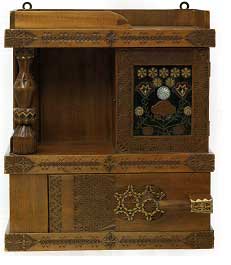
In his extensive account of the English section of the exhibition, Dmitri Grigorovich, the commissar of the Russian Department at the Exposition Universelle in Paris in 1867, praised the South Kensington Museum for its “educational environment” and its accessibility to all social classes. He quotes a certain Mr Koll who spoke at the museum’s opening in 1851, expressing a concern for improving the artistic quality of crafts and a call for “cultivating the artistic perception in society as a whole.” Everyone could profit from the artifacts and models exhibited at the museum, which were even occasionally donated by enthusiastic British citizens.
His sentiments were reflected in the wider artistic movements of the time, which claimed that the crafts had sunk low in the esteem of modern society and people were not able to enjoy labour anymore; in the words of British designer William Morris (1834-96), handicraftsmen had forsaken their task “to beautify the familiar matters of everyday life.”


In 1885, Mamontova appointed the artist Elena Polenova, a well-educated and multifaceted artist of her time, as artistic director of the workshop. Polenova set up a four-year training program, familiarized herself with the ins and outs of furniture-making and designed furniture herself, while actively collecting authentic peasant art from the different regions (Vladimir, Tula, Kostroma, Vologodsky, and others) as examples for her pupils. An Ethnographic Museum was established in Abramtsevo to house this collection.

It is also interesting to note that Polenova also challenged the gender roles that had been historically assigned to the fine and decorative arts. She experimented with oil paints, which most art institutions allowed only males to study. Meanwhile, her male colleagues began to experiment with what were considered more feminine arts such as ceramics. Although academically trained male artists had historically avoided the more practical craftwork, at Abramtsevo painters such as Vasily Polenov, Viktor Vasnetsov, Valentin Serov, Michael Vrubel, Konstantin Korovin, Alexander Golovin became, to a greater or lesser extent, involved with woodworking, ceramics, Theater design, and illustration work. Their involvement not only raised the artistic level of the crafts, but paved the way for future generations of artists to work in these disciplines. One need only think of the dynamic Theater sets of avant-gardists such as Natalya Goncharova and Lyubov Popova or the ceramics of Kazimir Malevich and Ilya Chashnik.

Russian crafts, however, seem to continue to be underestimated. The South Kensington Museum, praised for its educational facilities by Dmitri Grigorovich in 1867, is now the Victoria and Albert Museum. The V&A, as it is popularly called, recently held an exhibition called “International Arts and Crafts.” From this exhibition it is clear that the Russian arts and crafts are not properly credited in a so-called “international” contextual presentation of the Arts and Crafts. Their obscure presentation and under-representation highlight the low priority the curators of the V&A gave to presenting the Russian arts and crafts in that larger context.

Polenova designed this wall cupboard on the basis of sketches that she had made during her collecting trips throughout Russia. One sheet in her album clearly demonstrates that in the final design she combined sketches of several parts of other cupboards from different villages. She even noted the names of the villages and provinces where they could be found: the column in Bogoslov in the Yaroslavl province; the lower box in Komyagin; and the handle in Valishchevo. As a center piece, she carved a stylized strawberry plant with two strawberries and flowers. The flowers look like tulips (often depicted in folk art) and the other two flowers seem to 
Eager to preserve folk art, Polenova provided her students with authentic peasant artifacts at the Ethnographic Museum in Abramtsevo and artistic designs based on them of her own hand. In so doing, Polenova succeeded in Morris’ call “to beautify the familiar matters of everyday life,” to raise the crafts to a equal with fine art, to provide education and job opportunities for the lower classes and to enjoy work. Her wall cupboard and other furniture, made in accord with Nature, were duplicated and sold in significant numbers, beautifying the domestic interiors of many Russian and European consumers.






